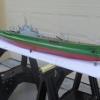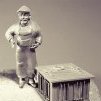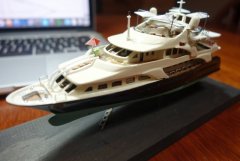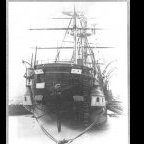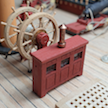Supplies of the Ship Modeler's Handbook are running out. Get your copy NOW before they are gone! Click on photo to order.
×
-
Posts
993 -
Joined
-
Last visited
Reputation Activity
-
 Wintergreen got a reaction from Piet in Young America 1853 by EdT - FINISHED - extreme clipper
Wintergreen got a reaction from Piet in Young America 1853 by EdT - FINISHED - extreme clipper
The amount of detail in your build Ed, is just breathtaking. Along with the mass of information in your posts. Your work is on a separate level from many of us.
But I must say that the Captain need to give his first mate a sharp word. Those launches can't just lay around on deck like that. They need to be strapped down or at least put to either side of the deck. Right now they make for an obstacle course should one need to hastily move from poop and forward.
-
 Wintergreen got a reaction from CiscoH in Kågen by Wintergreen - FINISHED - 1:30 - Swedish clinker-built cog work boat - SMALL
Wintergreen got a reaction from CiscoH in Kågen by Wintergreen - FINISHED - 1:30 - Swedish clinker-built cog work boat - SMALL
Okey, last post for the weekend.
Four strakes are on. As Vaddoc noted, they seemed to run high at the stem. Which I knew. This being learning by doing.
But, since wood is such a nice material to work with, things can be adjusted.
First picture. Before.
Second picture. After chisel and sandpaper.
I also have trouble amidships with the run of the planks dipping. No picture on that. Just a note to self.
Have a nice week!
-
 Wintergreen got a reaction from kees de mol in Kågen by Wintergreen - FINISHED - 1:30 - Swedish clinker-built cog work boat - SMALL
Wintergreen got a reaction from kees de mol in Kågen by Wintergreen - FINISHED - 1:30 - Swedish clinker-built cog work boat - SMALL
Okey, last post for the weekend.
Four strakes are on. As Vaddoc noted, they seemed to run high at the stem. Which I knew. This being learning by doing.
But, since wood is such a nice material to work with, things can be adjusted.
First picture. Before.
Second picture. After chisel and sandpaper.
I also have trouble amidships with the run of the planks dipping. No picture on that. Just a note to self.
Have a nice week!
-
 Wintergreen got a reaction from CiscoH in Kågen by Wintergreen - FINISHED - 1:30 - Swedish clinker-built cog work boat - SMALL
Wintergreen got a reaction from CiscoH in Kågen by Wintergreen - FINISHED - 1:30 - Swedish clinker-built cog work boat - SMALL
Thanks for the likes. Glad to see that there are readers.
Anyway, the day went. Grandkid came, and that was that. Now, she's asleep, so some time to type.
About spiling and clinker, or lapstrake, builds. This is my first attempt at this, so there will probably be lessons learned and working experience later on. However, compared to a carvel laid hull where planks fit long side to long side, and you quite easily can force later planks to the edge of the former, the clinker style means the planks overlap each other and thus form a stepped style. You probably know this already. Otherwise Wikipedia will help you understand.
From my short experience there are some major challenges with this.
You cannot force the plank in place sideways, it has to sit nicely. If force is used the overlap will be out of bounds. Hence, every plank needs more or less spiling. These boats are usually all about the shape. You have the sheer as with a carvel build. But with clinker we are reminded by every single strake if the run of the plank is off in some way. No steelers nor drop planks. Not an option. Every. single. strake. runs all the way from stem to stern. The challenge is to get the run of the planks right when the width of the plank changes. Eyeballing, proportional dividers, measure and measure again, then try. If not satisfied - repeat.
Unfortunately it is not as simple as just divide every frame/mould with decided number of strakes, then it will look very odd. As can be seen in my previous pictures the first strakes get wider at stem/stern. After two-three strakes the opposite will be true. All planks are narrower at stem/stern to fit in.
How to solve the issue with spiling. Basically it is the same as for carvel builds. Chuck, Druxey and others have written articles about it.
First I tried with cardboard of approximately same thickness as the planks. Didn't work too well. Hard to handle due to small size. Hard to see adjacent strake.
For the third strake I remembered that, I think, Chuck used transparent tape. It sticks to the moulds, easy to see and mark. Lacking transparent tape I used the regular painters masking tape and found that it was semi-transparent. Good enough.
One thing I picked up from Underhill's book was his practice of gluing thin material to a backing piece of cardboard or paper. My plank material is thin enough to easily be cut by #11, it will however splinter just as easily. With a broad piece of masking tape on one side - problem solved.
That had another advantage I found out later.
Enough text, show me some photos...
Here the cardboard templates are used.
Now, masking tape instead.
Stick tape to a white surface. Connect the dots with a smooth line.
Move tape to plank material and cut. Backing tape on other side.
The advantage with the backing tape is that it can be used as template for the accompanying plank port/starboard. By the way, leave the backing tape as long as possible.
Meaning all the rough shaping is already done. Every plank still need shaping to fit, but saved some time still.
Bending is performed with a dab of water and heatgun. Birch is very adaptable and bends easily. It holds edges fairly well also as can be seen in a previous post.
That was it for today.
To be continued...
-
 Wintergreen got a reaction from CiscoH in Kågen by Wintergreen - FINISHED - 1:30 - Swedish clinker-built cog work boat - SMALL
Wintergreen got a reaction from CiscoH in Kågen by Wintergreen - FINISHED - 1:30 - Swedish clinker-built cog work boat - SMALL
Hi guys,
the day is only half-gone here, but I just had to share this update with you.
First task for today was to clear a path to the shop... about 20cm/8" of snow overnight.
A short business trip took away a couple of days from the week, but back in the shop I made some progress.
Clinker/lapstrake is really something tricky to get right. Spiling and all that. In a later post I will show my trials and tribulations. On the trip I re-read H.A. Underhills chapter about clinker built boats, which was useful.
This far two full strakes are on. The scarphs are just plain butt ended with a backing piece on each. Joggled of course. Later each strake will be of three pieces.
Rubber bands and teak buns keep planks in place. I need to figure out some way to have the clamps not slipping off. Maybe a bit of tape will do the trick with enough friction.
Backing pieces have beveled edges for appearance. Should be pinned also, will see if I do that.
I am really enjoying this build. The result is far from perfect, but this is also my first time doing this. And since I have this first build as a practice run, my second will undoubtedly be better.
To be continued...
-
 Wintergreen got a reaction from Moab in Kågen by Wintergreen - FINISHED - 1:30 - Swedish clinker-built cog work boat - SMALL
Wintergreen got a reaction from Moab in Kågen by Wintergreen - FINISHED - 1:30 - Swedish clinker-built cog work boat - SMALL
Okey, last post for the weekend.
Four strakes are on. As Vaddoc noted, they seemed to run high at the stem. Which I knew. This being learning by doing.
But, since wood is such a nice material to work with, things can be adjusted.
First picture. Before.
Second picture. After chisel and sandpaper.
I also have trouble amidships with the run of the planks dipping. No picture on that. Just a note to self.
Have a nice week!
-
 Wintergreen got a reaction from popeye the sailor in Kågen by Wintergreen - FINISHED - 1:30 - Swedish clinker-built cog work boat - SMALL
Wintergreen got a reaction from popeye the sailor in Kågen by Wintergreen - FINISHED - 1:30 - Swedish clinker-built cog work boat - SMALL
Thought you'd find it familiar MT...
MP - no need to worry. We have this white stuff regularly here at 58 degrees north, like every once in a while every 12 months or so... last winter wasn't much, but this year there is more of it.
-
 Wintergreen got a reaction from Piet in Licorne 1755 by mtaylor - 3/16" scale - French Frigate - from Hahn plans - Version 2.0 - TERMINATED
Wintergreen got a reaction from Piet in Licorne 1755 by mtaylor - 3/16" scale - French Frigate - from Hahn plans - Version 2.0 - TERMINATED
Yep, that's tiny. Looks good though.
Keep it up Mark :-)
-
 Wintergreen reacted to G.L. in Oostends schipje by G.L. - scale 1:20 - Ostend shrimper - first POF - Edition 2
Wintergreen reacted to G.L. in Oostends schipje by G.L. - scale 1:20 - Ostend shrimper - first POF - Edition 2
14.30
The chain plates are glued and nailed to the bulwark after they have been blackened.
-
 Wintergreen got a reaction from popeye the sailor in Licorne 1755 by mtaylor - 3/16" scale - French Frigate - from Hahn plans - Version 2.0 - TERMINATED
Wintergreen got a reaction from popeye the sailor in Licorne 1755 by mtaylor - 3/16" scale - French Frigate - from Hahn plans - Version 2.0 - TERMINATED
Yep, that's tiny. Looks good though.
Keep it up Mark :-)
-
 Wintergreen got a reaction from kees de mol in Kågen by Wintergreen - FINISHED - 1:30 - Swedish clinker-built cog work boat - SMALL
Wintergreen got a reaction from kees de mol in Kågen by Wintergreen - FINISHED - 1:30 - Swedish clinker-built cog work boat - SMALL
Hi guys,
the day is only half-gone here, but I just had to share this update with you.
First task for today was to clear a path to the shop... about 20cm/8" of snow overnight.
A short business trip took away a couple of days from the week, but back in the shop I made some progress.
Clinker/lapstrake is really something tricky to get right. Spiling and all that. In a later post I will show my trials and tribulations. On the trip I re-read H.A. Underhills chapter about clinker built boats, which was useful.
This far two full strakes are on. The scarphs are just plain butt ended with a backing piece on each. Joggled of course. Later each strake will be of three pieces.
Rubber bands and teak buns keep planks in place. I need to figure out some way to have the clamps not slipping off. Maybe a bit of tape will do the trick with enough friction.
Backing pieces have beveled edges for appearance. Should be pinned also, will see if I do that.
I am really enjoying this build. The result is far from perfect, but this is also my first time doing this. And since I have this first build as a practice run, my second will undoubtedly be better.
To be continued...
-
 Wintergreen got a reaction from Canute in Licorne 1755 by mtaylor - 3/16" scale - French Frigate - from Hahn plans - Version 2.0 - TERMINATED
Wintergreen got a reaction from Canute in Licorne 1755 by mtaylor - 3/16" scale - French Frigate - from Hahn plans - Version 2.0 - TERMINATED
Yep, that's tiny. Looks good though.
Keep it up Mark :-)
-
 Wintergreen got a reaction from kees de mol in Kågen by Wintergreen - FINISHED - 1:30 - Swedish clinker-built cog work boat - SMALL
Wintergreen got a reaction from kees de mol in Kågen by Wintergreen - FINISHED - 1:30 - Swedish clinker-built cog work boat - SMALL
Thanks for the likes. Glad to see that there are readers.
Anyway, the day went. Grandkid came, and that was that. Now, she's asleep, so some time to type.
About spiling and clinker, or lapstrake, builds. This is my first attempt at this, so there will probably be lessons learned and working experience later on. However, compared to a carvel laid hull where planks fit long side to long side, and you quite easily can force later planks to the edge of the former, the clinker style means the planks overlap each other and thus form a stepped style. You probably know this already. Otherwise Wikipedia will help you understand.
From my short experience there are some major challenges with this.
You cannot force the plank in place sideways, it has to sit nicely. If force is used the overlap will be out of bounds. Hence, every plank needs more or less spiling. These boats are usually all about the shape. You have the sheer as with a carvel build. But with clinker we are reminded by every single strake if the run of the plank is off in some way. No steelers nor drop planks. Not an option. Every. single. strake. runs all the way from stem to stern. The challenge is to get the run of the planks right when the width of the plank changes. Eyeballing, proportional dividers, measure and measure again, then try. If not satisfied - repeat.
Unfortunately it is not as simple as just divide every frame/mould with decided number of strakes, then it will look very odd. As can be seen in my previous pictures the first strakes get wider at stem/stern. After two-three strakes the opposite will be true. All planks are narrower at stem/stern to fit in.
How to solve the issue with spiling. Basically it is the same as for carvel builds. Chuck, Druxey and others have written articles about it.
First I tried with cardboard of approximately same thickness as the planks. Didn't work too well. Hard to handle due to small size. Hard to see adjacent strake.
For the third strake I remembered that, I think, Chuck used transparent tape. It sticks to the moulds, easy to see and mark. Lacking transparent tape I used the regular painters masking tape and found that it was semi-transparent. Good enough.
One thing I picked up from Underhill's book was his practice of gluing thin material to a backing piece of cardboard or paper. My plank material is thin enough to easily be cut by #11, it will however splinter just as easily. With a broad piece of masking tape on one side - problem solved.
That had another advantage I found out later.
Enough text, show me some photos...
Here the cardboard templates are used.
Now, masking tape instead.
Stick tape to a white surface. Connect the dots with a smooth line.
Move tape to plank material and cut. Backing tape on other side.
The advantage with the backing tape is that it can be used as template for the accompanying plank port/starboard. By the way, leave the backing tape as long as possible.
Meaning all the rough shaping is already done. Every plank still need shaping to fit, but saved some time still.
Bending is performed with a dab of water and heatgun. Birch is very adaptable and bends easily. It holds edges fairly well also as can be seen in a previous post.
That was it for today.
To be continued...
-
 Wintergreen got a reaction from Rick01 in Enterprize by Rick01 - FINISHED - scale 1:48 - Topsail Schooner
Wintergreen got a reaction from Rick01 in Enterprize by Rick01 - FINISHED - scale 1:48 - Topsail Schooner
Rope coils are fun. Just like ratlines.
Just kidding, you've done a great job with your first scratch project Rick.
Regarding coils, it will help if you wet them with diluted white glue and then coil them, is my experience.
-
 Wintergreen got a reaction from Omega1234 in Licorne 1755 by mtaylor - 3/16" scale - French Frigate - from Hahn plans - Version 2.0 - TERMINATED
Wintergreen got a reaction from Omega1234 in Licorne 1755 by mtaylor - 3/16" scale - French Frigate - from Hahn plans - Version 2.0 - TERMINATED
Yep, that's tiny. Looks good though.
Keep it up Mark :-)
-
 Wintergreen reacted to Jim Lad in Kågen by Wintergreen - FINISHED - 1:30 - Swedish clinker-built cog work boat - SMALL
Wintergreen reacted to Jim Lad in Kågen by Wintergreen - FINISHED - 1:30 - Swedish clinker-built cog work boat - SMALL
Clinker planking is great fun, Håkan. On the only serious clinker hull I've built I used cardboard molds - they worked well for me.
I'd only just started planking my clinker hull when an old bloke stopped at the model makers' desk for a chat. Turned out he was a retired boat builder from Tasmania. He'd spent his entire working life building clinker boats. I asked him his advice on how to get the correct shape for each plank. He replied, "Well, just look at the shape of the hull and cut the plank." Oh, for 50 years experience in clinker building!
John
-
 Wintergreen reacted to mtaylor in Licorne 1755 by mtaylor - 3/16" scale - French Frigate - from Hahn plans - Version 2.0 - TERMINATED
Wintergreen reacted to mtaylor in Licorne 1755 by mtaylor - 3/16" scale - French Frigate - from Hahn plans - Version 2.0 - TERMINATED
Thanks for the comments and the likes, everyone.
I cleaned up the laser char on one carriage and assembled it. Now to wait for the guns from Chuck... <patience grasshopper, patience> I forgot how tiny and fiddly they are to assemble. So when the guns get here, I'll adjust as needed and make the quoins so that they will all be at the same elevation. I think this will be a slow process as it took me a couple of hours to clean off the char and fit everything. Hopefully with a bit of practise, I'll pick up speed.
-
 Wintergreen got a reaction from CaptainSteve in Kågen by Wintergreen - FINISHED - 1:30 - Swedish clinker-built cog work boat - SMALL
Wintergreen got a reaction from CaptainSteve in Kågen by Wintergreen - FINISHED - 1:30 - Swedish clinker-built cog work boat - SMALL
Thanks for the likes. Glad to see that there are readers.
Anyway, the day went. Grandkid came, and that was that. Now, she's asleep, so some time to type.
About spiling and clinker, or lapstrake, builds. This is my first attempt at this, so there will probably be lessons learned and working experience later on. However, compared to a carvel laid hull where planks fit long side to long side, and you quite easily can force later planks to the edge of the former, the clinker style means the planks overlap each other and thus form a stepped style. You probably know this already. Otherwise Wikipedia will help you understand.
From my short experience there are some major challenges with this.
You cannot force the plank in place sideways, it has to sit nicely. If force is used the overlap will be out of bounds. Hence, every plank needs more or less spiling. These boats are usually all about the shape. You have the sheer as with a carvel build. But with clinker we are reminded by every single strake if the run of the plank is off in some way. No steelers nor drop planks. Not an option. Every. single. strake. runs all the way from stem to stern. The challenge is to get the run of the planks right when the width of the plank changes. Eyeballing, proportional dividers, measure and measure again, then try. If not satisfied - repeat.
Unfortunately it is not as simple as just divide every frame/mould with decided number of strakes, then it will look very odd. As can be seen in my previous pictures the first strakes get wider at stem/stern. After two-three strakes the opposite will be true. All planks are narrower at stem/stern to fit in.
How to solve the issue with spiling. Basically it is the same as for carvel builds. Chuck, Druxey and others have written articles about it.
First I tried with cardboard of approximately same thickness as the planks. Didn't work too well. Hard to handle due to small size. Hard to see adjacent strake.
For the third strake I remembered that, I think, Chuck used transparent tape. It sticks to the moulds, easy to see and mark. Lacking transparent tape I used the regular painters masking tape and found that it was semi-transparent. Good enough.
One thing I picked up from Underhill's book was his practice of gluing thin material to a backing piece of cardboard or paper. My plank material is thin enough to easily be cut by #11, it will however splinter just as easily. With a broad piece of masking tape on one side - problem solved.
That had another advantage I found out later.
Enough text, show me some photos...
Here the cardboard templates are used.
Now, masking tape instead.
Stick tape to a white surface. Connect the dots with a smooth line.
Move tape to plank material and cut. Backing tape on other side.
The advantage with the backing tape is that it can be used as template for the accompanying plank port/starboard. By the way, leave the backing tape as long as possible.
Meaning all the rough shaping is already done. Every plank still need shaping to fit, but saved some time still.
Bending is performed with a dab of water and heatgun. Birch is very adaptable and bends easily. It holds edges fairly well also as can be seen in a previous post.
That was it for today.
To be continued...
-
 Wintergreen got a reaction from Keith Black in HMS Sirius 1797 by paulsutcliffe - 1:48 - POF from NMM plans
Wintergreen got a reaction from Keith Black in HMS Sirius 1797 by paulsutcliffe - 1:48 - POF from NMM plans
Haha, about all that c**p in the background... you should see my photos. All kinds of weird stuff. I think it makes for interesting thoughts "wonder what he will use THAT for"
Oh, and also, very nice launches Paul. Keep it up.
-
 Wintergreen got a reaction from robdurant in HMS Bellona 1760 by SJSoane - Scale 1:64 - English 74-gun - as designed
Wintergreen got a reaction from robdurant in HMS Bellona 1760 by SJSoane - Scale 1:64 - English 74-gun - as designed
Mark, your Bellona is a very handsome model.
Great work.
-
 Wintergreen got a reaction from Piet in Meteor 1851 by Jim Lad - Scale 1:96 - Immigrant Ship
Wintergreen got a reaction from Piet in Meteor 1851 by Jim Lad - Scale 1:96 - Immigrant Ship
Good progress there John despite everything around you.
I reckon that the space is limited at 1:96 even if you state the opposite. Reckon you have one of those mini yardsmen with an adze at your service...
-
 Wintergreen got a reaction from popeye the sailor in Kågen by Wintergreen - FINISHED - 1:30 - Swedish clinker-built cog work boat - SMALL
Wintergreen got a reaction from popeye the sailor in Kågen by Wintergreen - FINISHED - 1:30 - Swedish clinker-built cog work boat - SMALL
Thanks for the likes. Glad to see that there are readers.
Anyway, the day went. Grandkid came, and that was that. Now, she's asleep, so some time to type.
About spiling and clinker, or lapstrake, builds. This is my first attempt at this, so there will probably be lessons learned and working experience later on. However, compared to a carvel laid hull where planks fit long side to long side, and you quite easily can force later planks to the edge of the former, the clinker style means the planks overlap each other and thus form a stepped style. You probably know this already. Otherwise Wikipedia will help you understand.
From my short experience there are some major challenges with this.
You cannot force the plank in place sideways, it has to sit nicely. If force is used the overlap will be out of bounds. Hence, every plank needs more or less spiling. These boats are usually all about the shape. You have the sheer as with a carvel build. But with clinker we are reminded by every single strake if the run of the plank is off in some way. No steelers nor drop planks. Not an option. Every. single. strake. runs all the way from stem to stern. The challenge is to get the run of the planks right when the width of the plank changes. Eyeballing, proportional dividers, measure and measure again, then try. If not satisfied - repeat.
Unfortunately it is not as simple as just divide every frame/mould with decided number of strakes, then it will look very odd. As can be seen in my previous pictures the first strakes get wider at stem/stern. After two-three strakes the opposite will be true. All planks are narrower at stem/stern to fit in.
How to solve the issue with spiling. Basically it is the same as for carvel builds. Chuck, Druxey and others have written articles about it.
First I tried with cardboard of approximately same thickness as the planks. Didn't work too well. Hard to handle due to small size. Hard to see adjacent strake.
For the third strake I remembered that, I think, Chuck used transparent tape. It sticks to the moulds, easy to see and mark. Lacking transparent tape I used the regular painters masking tape and found that it was semi-transparent. Good enough.
One thing I picked up from Underhill's book was his practice of gluing thin material to a backing piece of cardboard or paper. My plank material is thin enough to easily be cut by #11, it will however splinter just as easily. With a broad piece of masking tape on one side - problem solved.
That had another advantage I found out later.
Enough text, show me some photos...
Here the cardboard templates are used.
Now, masking tape instead.
Stick tape to a white surface. Connect the dots with a smooth line.
Move tape to plank material and cut. Backing tape on other side.
The advantage with the backing tape is that it can be used as template for the accompanying plank port/starboard. By the way, leave the backing tape as long as possible.
Meaning all the rough shaping is already done. Every plank still need shaping to fit, but saved some time still.
Bending is performed with a dab of water and heatgun. Birch is very adaptable and bends easily. It holds edges fairly well also as can be seen in a previous post.
That was it for today.
To be continued...
-
 Wintergreen got a reaction from robdurant in HMS Sirius 1797 by paulsutcliffe - 1:48 - POF from NMM plans
Wintergreen got a reaction from robdurant in HMS Sirius 1797 by paulsutcliffe - 1:48 - POF from NMM plans
Haha, about all that c**p in the background... you should see my photos. All kinds of weird stuff. I think it makes for interesting thoughts "wonder what he will use THAT for"
Oh, and also, very nice launches Paul. Keep it up.
-
 Wintergreen got a reaction from Canute in HMS Sirius 1797 by paulsutcliffe - 1:48 - POF from NMM plans
Wintergreen got a reaction from Canute in HMS Sirius 1797 by paulsutcliffe - 1:48 - POF from NMM plans
Haha, about all that c**p in the background... you should see my photos. All kinds of weird stuff. I think it makes for interesting thoughts "wonder what he will use THAT for"
Oh, and also, very nice launches Paul. Keep it up.
-
 Wintergreen got a reaction from hexnut in Kågen by Wintergreen - FINISHED - 1:30 - Swedish clinker-built cog work boat - SMALL
Wintergreen got a reaction from hexnut in Kågen by Wintergreen - FINISHED - 1:30 - Swedish clinker-built cog work boat - SMALL
Thanks for the likes. Glad to see that there are readers.
Anyway, the day went. Grandkid came, and that was that. Now, she's asleep, so some time to type.
About spiling and clinker, or lapstrake, builds. This is my first attempt at this, so there will probably be lessons learned and working experience later on. However, compared to a carvel laid hull where planks fit long side to long side, and you quite easily can force later planks to the edge of the former, the clinker style means the planks overlap each other and thus form a stepped style. You probably know this already. Otherwise Wikipedia will help you understand.
From my short experience there are some major challenges with this.
You cannot force the plank in place sideways, it has to sit nicely. If force is used the overlap will be out of bounds. Hence, every plank needs more or less spiling. These boats are usually all about the shape. You have the sheer as with a carvel build. But with clinker we are reminded by every single strake if the run of the plank is off in some way. No steelers nor drop planks. Not an option. Every. single. strake. runs all the way from stem to stern. The challenge is to get the run of the planks right when the width of the plank changes. Eyeballing, proportional dividers, measure and measure again, then try. If not satisfied - repeat.
Unfortunately it is not as simple as just divide every frame/mould with decided number of strakes, then it will look very odd. As can be seen in my previous pictures the first strakes get wider at stem/stern. After two-three strakes the opposite will be true. All planks are narrower at stem/stern to fit in.
How to solve the issue with spiling. Basically it is the same as for carvel builds. Chuck, Druxey and others have written articles about it.
First I tried with cardboard of approximately same thickness as the planks. Didn't work too well. Hard to handle due to small size. Hard to see adjacent strake.
For the third strake I remembered that, I think, Chuck used transparent tape. It sticks to the moulds, easy to see and mark. Lacking transparent tape I used the regular painters masking tape and found that it was semi-transparent. Good enough.
One thing I picked up from Underhill's book was his practice of gluing thin material to a backing piece of cardboard or paper. My plank material is thin enough to easily be cut by #11, it will however splinter just as easily. With a broad piece of masking tape on one side - problem solved.
That had another advantage I found out later.
Enough text, show me some photos...
Here the cardboard templates are used.
Now, masking tape instead.
Stick tape to a white surface. Connect the dots with a smooth line.
Move tape to plank material and cut. Backing tape on other side.
The advantage with the backing tape is that it can be used as template for the accompanying plank port/starboard. By the way, leave the backing tape as long as possible.
Meaning all the rough shaping is already done. Every plank still need shaping to fit, but saved some time still.
Bending is performed with a dab of water and heatgun. Birch is very adaptable and bends easily. It holds edges fairly well also as can be seen in a previous post.
That was it for today.
To be continued...



